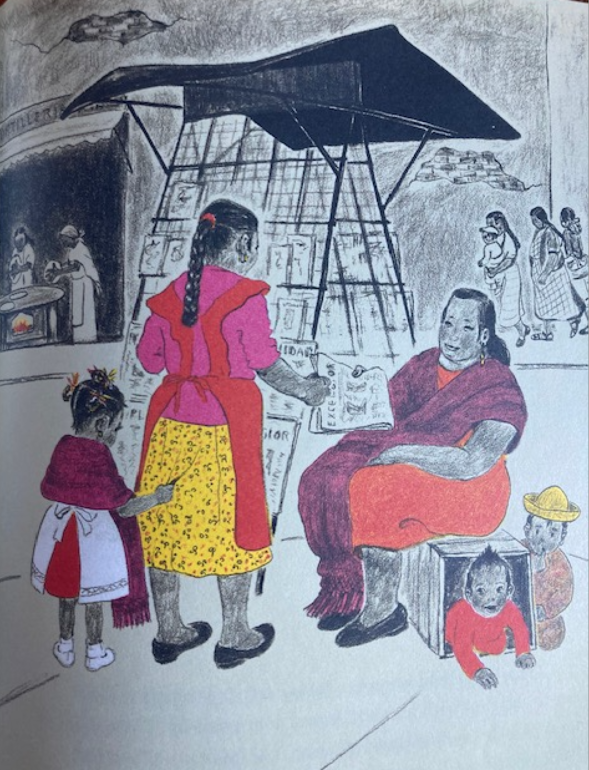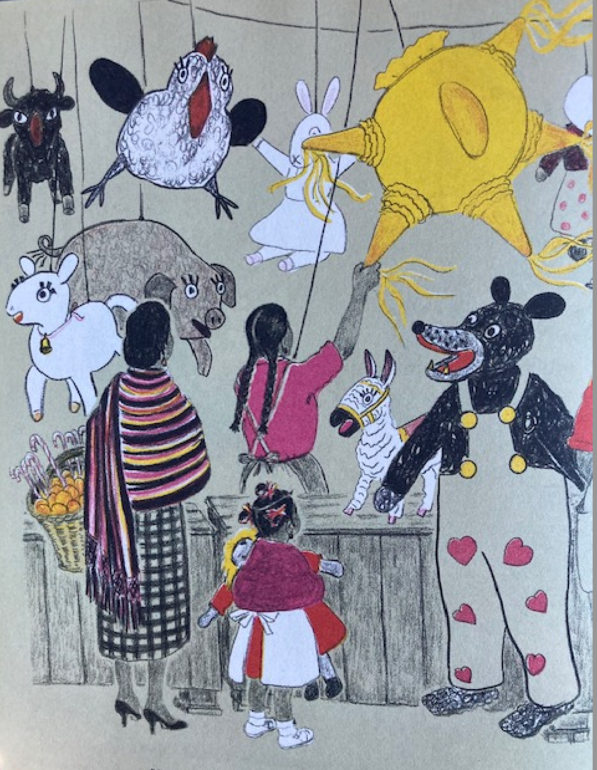
My high school Spanish textbook
*
December 17, 2023
by Philip Gambone
This year will be my first Christmas in Mexico. I am especially looking forward to the posadas, the nine-day festival that enacts Mary and Joseph's search for an inn (posada) on their way toward Bethlehem. Many years ago, when I studied Spanish in high school in the old El Camino Real series (does anyone else remember those textbooks?), we learned that a posada was a Christmas party. "Nine families take turns giving the successive parties," the book explained, "and everyone goes to them all." Well, a posada, I have subsequently learned, is a bit more than that, but the book caught the gist of it.
Posada celebrations begin on el diez y seis de diciembre and feature songs, dances, house-to-house processions, and the breaking of candy-filled piñatas. When, a few years ago, I saw Leonard Brooks' mysterious and wonderfully atmospheric painting "Posada" at an exhibition of his work at Casa Europa, I became intrigued and ever since have wanted to learn more about this beautiful Yuletide ritual.

Posada by Leonard Brooks
*
And what better way to understand these Christmas festivals than through the eyes of a child? Or through the eyes and artistry of a children's book illustrator? One of the most beloved American children's Christmas books turns out to be Marie Hall Ets' Nine Days to Christmas, the story of a little Mexican girl about to experience her first posada. Ets, who wrote and illustrated 21 children's books, won the prestigious Caldecott Medal in 1959 for her Christmas book. "Few children's books can boast a more beautiful title page and a more complete unity of design, illustration and format," wrote Elizabeth H. Gross, a children's book librarian and professor of Library Science.
Ets was born in 1895 in North Greenfield, Wisconsin. As a child—"from the time she could hold a pencil or a brush," her editor said—she demonstrated impressive artistic gifts. After skipping grades in junior high and high school, she graduated in 1911 from Fond du Lac High School and enrolled at Lawrence College in Appleton, Wisconsin, where she began to study art. After one year, she dropped out, deciding she wanted to attend a real art school. With money borrowed from her parents, she went to New York only to learn that no one under 18 was allowed in the life drawing classes. Instead, she studied interior decoration at what is now the Parsons School of Design. Diploma in hand, she moved to California, taking jobs as a sketch artist for decorators in San Francisco and Los Angeles. She married in 1917, but her husband, who had enlisted in the Army, caught measles and pneumonia and died the next year.

Marie Hall Ets
*
Ets left her work as a sketch artist and moved back to the Midwest, taking on various jobs as a social worker. She entered the University of Chicago, earning a Bachelor of Philosophy degree in 1924. As a social worker, her primary focus was children. One of her biographers writes, "It was this experience that first brought to Ets the awareness of the near absence of people of color in children's books." In 1935, she published Mister Penny, her first book for children.
Around this time, she married again. Her new husband, Harold Ets, was a faculty member at the Loyola University School of Medicine. It was because of his work with human embryos that Ets was inspired to write what she considered her most important contribution to children's literature, The Story of a Baby (1939). "The book," another biographer notes, "unique for its appeal to children and its scientifically accurate drawings, is often noted as a pioneer in sex education." Ten more children's books followed before, in 1959, Ets wrote Nine Days to Christmas.

Ets co-authored the book with Aurora Labastida, whom she met during the two winters she spent in Mexico City. Labastida, who was the children's librarian at the U.S. Embassy's Benjamin Franklin Library, was dismayed at the depiction of Mexicans in books for children, where they were so often portrayed as "villagers wearing ponchos and following burros." She wanted to write a story that showed Mexican city children using "bathtubs and gas stoves like ours," Ets noted in her Caldecott acceptance speech.
The two women jointly worked on the story, Labastida writing the majority of the text, which placed a Mexican girl in an urban setting, one that she hoped would "show the similarities in the lives of children from different countries and cultures." Ets filled in the details before adding the illustrations.

Ceci considers the piñatas
*
In her speech, Ets recounted how she had spent time in Chapultepec Park and in the markets of Mexico City, "surrounded by crowds who gathered around, "watching and asking questions." She aimed to make her drawings as true to life as possible, so that "people would be able to recognize themselves and each other."
While she used Labastida's niece as the model for the story's little girl, Ceci, Ets ultimately considered her "too large and too blonde" and ended up drawing her protagonist from imagination. All the many other characters in the book were drawn from real people. "They have been delighted to recognize themselves and each other in the pictures," she said. What she didn't foresee was that the children whose faces did not get into the book ended up feeling "slighted and hurt."
In the book, Ceci, who is in kindergarten, learns that Christmas is coming. One day, she hears her mother and her aunts making plans for a posada. They want to have the first of the nine parties at their house. Ceci wants to know if the party will include a piñata. "You wait and see," her mother tells her.

Talking to the ducks
*
As the days pass and kindergarten is let out for the holiday vacation, Ceci becomes more and more eager for the first of the posadas and her piñata. In the park, she tells the ducks, "I'm going to have a posada. And maybe I'll have a piñata." Later, waiting on the street with the neighborhood servant girls for the garbage truck, she again talks excitedly about the posada.

Waiting for the trash collectors
*

Going into Town
*
One day, her mother announces that she has a surprise for Ceci: she has decided to take her daughter to the old Christmastime market, where they will pick out a piñata for the party. At the market, Ceci is enchanted by all the piñatas, each one calling out to her to choose them. She doesn't know which one to pick until suddenly she stops in front of a big, shining gold star. "You're the most beautiful piñata in the world!" she exclaims.

At the market with her mother
*

Picking out a piñata
*
"It's the star that showed the Wise Men where to find the baby Jesus," her mother tells her. Ceci excitedly decides that's the one she wants. They buy the big star and take it home. There, Ceci helps fill the piñata with fruit and sweets. Her brother strings it up between two jacaranda trees in the family courtyard. Soon after dark, the guests arrive and the procession that kicks off every posada begins. When it comes time for the children to break the piñata, a crisis arises. Ceci refuses to participate. "Don't let them break my piñata!" she cries. How will this dilemma play out? (Gentle Readers, to learn how the story ends, you'll have to get ahold of a copy of this charming children's book and read it for yourselves.)

Breaking the piñata
*
When she gave her acceptance speech for the Caldecott Award, Ets addressed the issue of stereotyping. "Mexicans, as I learned after living in their country for some time, have long resented our children's books on Mexico. [They] say that since almost half of their people live in cities, it isn't fair that we always show them as poor village Indians." She acknowledged that the pull of the "picturesque and exotic" was strong.
As an example of including a less "exotic," more urban lifestyle, Ets said that she drew the piñata shop with a view out toward the street. There she added antennas on the roofs of buildings. "I wanted to show the aerials on the roofs beyond so that children in the States could see for themselves that Mexicans, too, have television."

Caldecott Award 1959
*
Marie Hall Ets went on to write several more children's book. Her last one came out in 1974. She died ten years later in Inverness, Florida, at age 89.
In a short history of the Caldecott Medals, Frederic G. Melcher noted that writers, artists, publishers and librarians can point out books of distinction, "but only readers in succeeding generations can make them ‘classics.'" Marie Hall Ets' Nine Days to Christmas is just such a classic. It is still in print, and a Spanish-language edition also exists. If you have children or grandchildren or great-grandchildren who celebrate Christmas, Ets' classic is a perfect Christmastime read. In fact, it's a lovely read as well for the child still lurking in the adult.
**************

Philip Gambone, a retired high school English teacher, also taught creative and expository writing at Harvard for twenty-eight years. He is the author of five books, most recently As Far As I Can Tell: Finding My Father in World War II, which was named one of the Best Books of 2020 by the Boston Globe. It is available through Amazon, at the Biblioteca bookshop, and at Aurora Books off the Calzada de la Aurora.
**************
*****
Please contribute to Lokkal,
SMA's online collective:
 ***
***
Discover Lokkal:
Watch the two-minute video below.
Then, just below that, scroll down SMA's Community Wall.
Mission

Visit SMA's Social Network
Contact / Contactar

